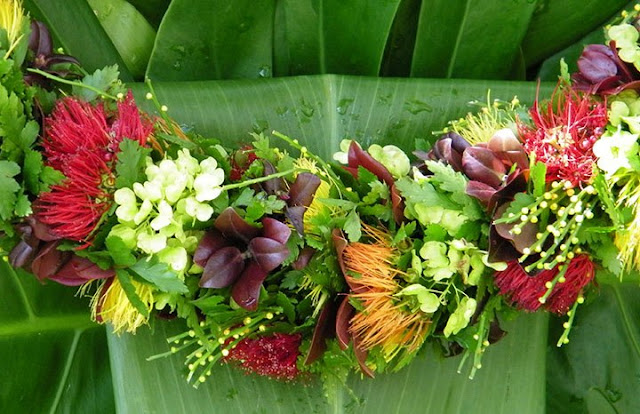As soon as you step off the plane and
set your foot on this tropical paradise on earth, you get a warm welcome with a
traditional lei or floral garland and you instantly get into the spirit of
‘Aloha’. In fact, there is a lei stand at each airport. It’s the island way of
welcoming the guest to our ‘Aina’.
Specialized airport lei greeting services
are also provided by many small businesses to welcome the guests at airports.
Lei is the Hawaiian word for garland
or wreath. The tradition of lei was introduced in Hawaiian Islands by early
Polynesian voyagers who arrived here from Tahiti, sailing in canoes and
navigating by guidance from stars. In ancient times, the Maile lei was
offered as a part of peace agreement between heads of opposite clan.
 |
| making of lei |
They used to make lei form various materials
like nuts, feathers, seeds, flowers, leaves and even bone and teeth of various
animals. There are leis worn and exchanged for every important occasion in life
like for grief, for love, lei for love-making and marriages, for a birth in
family. Lei was worn when farmers
blessings the new crop, fisherman’s going out to sea for catch or people going
on voyages, priest chanting in the heiau.
Most common people in Hawaii used to wear
open-ended horseshoe fashion, long lasting lei made of the spicy scented green
maile stems and leaves. Maile is a native Hawaiian vine, with shiny
fragrant leaves and the lei very popular at weddings,
graduations and especially proms.
The maile is the most traditional
wedding lei, as it was used by the Kahuna (Hawaiian priest) in old Hawaii to
bind the hands of the bride and groom, symbolizing their commitment to each
other.
 |
| Maile |
Most visitors are only familiar with
the plumeria lei, because it is widely available at airports and hotels. The
plumeria is a relative newcomer in the old tradition of making lei with pikake,
jade vine and Ilima . Harder to find is the lei pikake with its unequaled
perfume.
 |
| Plumeria lei courtesy: getty images |
 |
| pikake lei |
Today, Leis are a symbol of
appreciation, love, affection, respect and is perhaps the physical
manifestation of Aloha spirit. Lei are available all through the island and can also be shipped on order.
all through the island and can also be shipped on order.
The royal court procession has eight
princesses, each representing a different Hawaiian island -- accompanied by a
man carrying a kāhili -- a feathered staff used in ancient
times as a symbol of royalty.
Each of the 8 Hawaiian Islands has its
own official color and lei, based on a flower or foliage that is endemic to
that island or once thrived there. The Lei Day princess wears the color of the
island she is representing and be draped in the proper accompanying lei. The
following is information about 8 islands and the respective lei adapted from
Kings Hawaiian blog contributed by Marie Tutko.
- White: Niʻihau, “The Forbidden Isle,” and a lei
of made of pūpū(shells). Niʻihau is the only island
represented by a shell, as its residents are famous for the intricate lei
they craft out of shells that can only be found on that island.
- Purple: Kauaʻi, “The Garden Isle,” and a lei made from the
rare, anise-scented mokihana berry.
- Yellow: Oʻahu, “The Gathering Place, and a lei of golden ʻilima flowers.
- Green: Molokaʻi, “The Friendly Isle,” and a lei
of polished kukui (candlenuts).
- Orange: Lānaʻi, “The Pineapple Island,” (because of the island’s
long history as a pineapple plantation) and a lei of kaunaʻoa, a
native, leafless vine.
- Gray: Kahoʻolawe, “The Target Island,” (the uninhabited
island was used by U.S. Armed Forces for live-fire training and test
explosions for decades), and a lei of hinahina, a native,
silvery heliotrope that grows on the beach.
- Pink: Maui, “The Valley Isle,” and a lei of lokelani (a
small rose).
- Red: The island of Hawaiʻi, “The Big Island,” and lei of ʻōhiʻa
lehua, a native honey plant. The red ʻōhiʻa lehuais
often the first shrub that will sprout from a recent lava flow.
 |
| Lei day competition |
 |
| Winning lei at Lei day Photo: Joel |
 |
| Aunty Amelia Bailey creating a beautiful haku lei. Photo courtesy of Hawaii Tourism Authority (HTA) / Tor Johnson. |
 |
| Mayor with Lei day queen |
Etiquette's of Lei
 |
| graduates at commencement |
Last, but not least, there is one more
taboo…never present a pregnant woman a closed lei. Hawaiians feel that a closed
lei around the neck is bad luck for the unborn child. (Head Hakus and
open-ended leis are acceptable to give to pregnant woman.)
Finally,
there is also tradition to dispose of lei properly. It should never be thrown
in garbage. It should be returned to nature by hanging on the tree, burying it
or unstringing it and offering the flowers to the sea.
Now,
knowing more about the history and etiquettes about lei, I am sure you can’t resist the vibrant colors, the intoxicating
fragrances, or the beautiful tradition of Hawaii’s most recognized icon…the
flower lei. Simply enjoy the lei for its beauty and fragrance, and get into the
Aloha spirit.





No comments:
Post a Comment